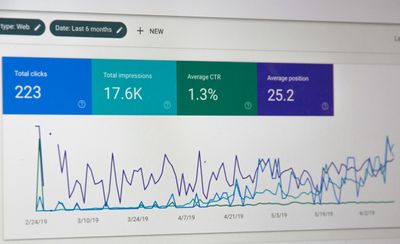In today's digital age, establishing an online presence for your business is crucial for reaching a wider audience, building brand awareness, and increasing sales.
Having a strong online presence can also help you stay ahead of the competition and establish your business as a thought leader in your industry. Whether it's through a website, social media, or other digital marketing strategies, creating an effective online presence requires careful planning, execution, and ongoing maintenance.
In this blog post, we'll explore the key elements of establishing a successful online presence for your business, including website design, content creation, and digital marketing tactics.
Ways to Establish your Online Presence
Here are some methods for building your online presence:
- Have a Website: A professional website is the cornerstone of any online presence. It provides a platform to showcase your products and services, as well as a way to share valuable content with your audience. Registry Australia provides complete web portal services including webhosting, domain name registration, website development, and even email hosting. You can check our services here.
- Be present on Social media: Social media platforms such as Facebook, Twitter, Instagram, and LinkedIn can be used to build brand awareness, engage with your audience, and drive traffic to your website.
- Leverage Email marketing: Use email marketing to reach your audience directly and build relationships with your customers.
- Content marketing: Create valuable, relevant content that your target audience will find engaging and informative. Share your content on your website, social media platforms, and other channels to reach a wider audience.
- Pay-per-click advertising (PPC): Use pay-per-click advertising to drive targeted traffic to your website and increase conversions.
- Influencer marketing: Partner with influencers in your industry to reach a wider audience and build brand awareness.
- Video marketing: Use video to showcase your products, services, and brand story, and share your videos on social media and your website.
- Online reputation management: Monitor and manage your online reputation by monitoring reviews, responding to customer feedback, and proactively addressing any issues.
- Google Maps: If your business has some physical presence, make sure your business is listed on Google Maps, with accurate information and a complete profile. This will make it easier for customers to find your location, get directions, and read reviews.
Step By Step Guide to Establish a Website for your Business
Step-by-Step Guide to Establishing a Professional Website:
- Determine the purpose of your website: Determine what you want to achieve with your website, such as generating leads, selling products, or providing information to your customers. This will help guide the design and content of your website. You can read more here "**Do I Need a Website for my Business"**
- Select a web hosting provider and Choose a domain name: Choose a reputable web hosting provider that offers reliable uptime, fast loading times, and 24/7 customer support. Choose a domain name that is simple, memorable, and related to your business. Your domain name should be easy to type and easy to remember, and it should represent your brand in the best possible light.
Read more about choosing a perfect domain name for your business.
You can choose Registry Australia for the following services:
- Choose a website builder or hire a web designer: If you have no experience with web design, go nowhere, we can provide a professional web development service to create a custom website for you. Moreover, you can use our drag-and-drop easy-to-use website builder.
- Add high-quality content: Fill your website with high-quality content that is relevant to your business and provides value to your visitors. This includes text, images, videos, and other types of multimedia.
- Optimise for search engines: Make sure that your website is optimised for search engines so that it ranks well in search results. This involves using keywords, meta descriptions, and other optimisation techniques.
- Launch your website: Once you have completed all the steps, you can launch your website and start promoting it to your target audience.
- Maintain your website: Regularly update your website with new content, and make any necessary updates to the design and functionality. This will help keep your website relevant and improve its overall performance.
By following these steps, you can establish a professional website for your business that will help you build a strong online presence.
Best Practices to Create Effective and Engaging Content
Here are three best practices for creating effective and engaging content for your website and social media channels:
- Know your audience: Understanding your target audience is critical to creating content that resonates with them. You should consider their needs, interests, and pain points when creating content that is relevant and valuable to them.
- Be visually appealing: Using images, videos, and other multimedia elements can help make your content more engaging and visually appealing. This can help capture the attention of your audience and keep them interested in your content.
- Be consistent and authentic: Consistently creating and sharing high-quality content will help you build a strong online presence and establish yourself as a trusted and reliable source of information. It's also important to be authentic and true to your brand voice, as this will help build trust with your audience.
Website SEO Tips
Here are a few tips on how to use search engine optimisation (SEO) to improve search engine rankings and drive traffic to your website:
- Keyword research: Identify the keywords and phrases that your target audience is searching for and use them in your website content and meta tags.
- On-page optimisation: Make sure your website is optimised for search engines by using proper HTML tags, including header tags, meta descriptions, and alt tags for images.
- Quality content: Create high-quality, valuable content that provides value to your audience and is optimised for search engines. This can include blog posts, articles, and other types of content.
- Backlinks: Acquire high-quality backlinks from reputable websites to show search engines that your website is credible and valuable.
- Mobile optimisation: Make sure your website is mobile-friendly, as this is a critical factor in search engine rankings.
- Page load speed: Improve your website's page load speed, as this is another important factor in search engine rankings.
Using Social Media for Online Presence
To effectively use social media, start by creating a strategic plan that outlines your goals and target audience. Then, choose the social media platforms that are most relevant to your audience and start creating valuable, engaging content. This can include blog posts, images, videos, and other types of content that align with your brand and target audience. Make sure to also interact with your followers by responding to comments, messages, and reviews. You can also run social media contests and promotions to drive engagement and build your following. Additionally, consider using paid social media advertising to reach a wider audience and drive traffic to your website.
Best practices for maintaining an active and relevant online presence
- Regularly update and maintain your website and social media channels: Consistently creating and sharing high-quality content will help you build a strong online presence and establish yourself as a trusted and reliable source of information. Regular updates and maintenance can also help improve your website's search engine rankings.
- Monitor your analytics: Use tools like Google Analytics to track your website's performance and understand how your audience is engaging with your content. This can help you identify areas for improvement and make data-driven decisions to optimise your online presence.
- Evaluate and adjust your strategy: Regularly evaluate your online presence and adjust your strategy as needed based on your performance and audience engagement. This can include modifying your content, adjusting your social media schedule, or exploring new platforms and opportunities to reach your target audience.
Don't miss out on the opportunity to establish and grow your online presence! At Registry Australia, we offer a comprehensive suite of services to help you create a professional website and register your business online.
So what are you waiting for? Take control of your online presence today by contacting us at Registry Australia. Let us help you reach your full potential online and drive business success.





